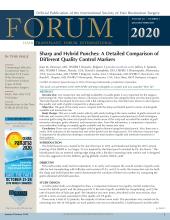Abstract
Background: Follicular unit excision (FUE) has come a long way in establishing itself as an alternative technique for hair restoration. There exists a plethora of scholarly work on FUE, albeit there is a paucity of evidence on variables that affect the outcome of revision FUE. A successful hair restoration surgery is, among other things, predicated on the surgery's follicular transection rate (FTR).
Objective: The objective of this study was to determine whether there is an association between FTR and the type of hair restoration surgery patients had prior to their revision FUE; three surgical procedures were compared: strip harvesting (SH), FUE, and punch grafting (PG).
Material & Methods: The sample size for this exploratory study was 40 (i.e., n=40), and all the subjects were men with different grades of androgenetic alopecia. The subjects had undergone an FUE revision surgery from January to December 2014, and had their FTR and partial transection rate (PTR) calculated for each session. We compared patients' FTR and PTR among cases who had undergone various hair restoration techniques prior to their revision FUE. We defined FTR as complete transection of the graft, where all follicles in the graft are transected; PTR was defined as the incomplete transection of the graft, where at least one follicle in a graft is intact. Chi-square test of independence was conducted to compare FTR and PTR across revision FUE cases of patients who previously underwent SH, PG, or FUE.
Results: Out of a total of 40 cases, 52.5% (21) had undergone FUE surgery earlier, 35% (14) SH, and 12.5% (5) PG as the primary surgery. The average FTR in patients who had undergone strip surgery earlier was 3.22 per 100 grafts, while it was 3.33 per 100 grafts and 3.54 per 100 grafts in those who had undergone previous FUE and punch grafting, respectively. Chi-square test of independence showed that there was no significant relationship between the type of hair restoration procedure cases had prior to their revision FUE and the FTR and PTR. Nonetheless, our results support a trend where FTR and PTR are likely to be high if the prior surgery is FUE; moreover, post-hoc calculations for statistical power showed that the current study was under-powered.
Conclusion: Our findings suggest the type of hair restoration surgery men with androgenetic alopecia underwent prior to having a revision FUE might influence the success of the revision FUE. In addition, we noted revision FUE cases of male androgenetic alopecia are least likely to have high FTR if they had previously undergone strip harvesting. Furthermore, our calculations for statistical power from our exploratory study would be very useful for sample size determination in future studies.
- Copyright © 2020 by the International Society of Hair Restoration Surgery
This article requires a subscription to view the full text. If you have a subscription you may use the login form below to view the article.






